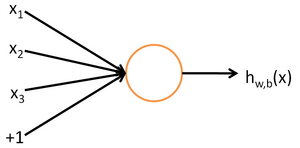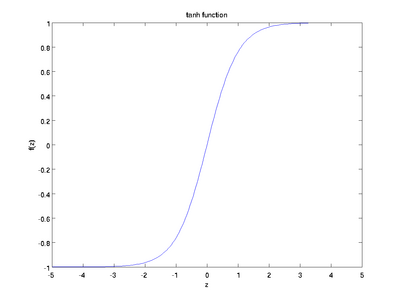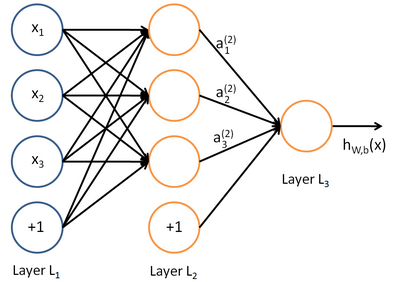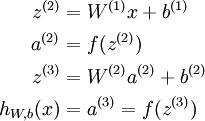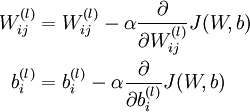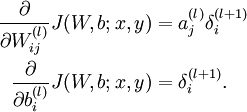Sparse Autoencoder(一)
Neural Networks
We will use the following diagram to denote a single neuron:
This "neuron" is a computational unit that takes as input x1,x2,x3 (and a +1 intercept term), and outputs
, where
is called the activation function. In these notes, we will choose
to be the sigmoid function:
Thus, our single neuron corresponds exactly to the input-output mapping defined by logistic regression.
Although these notes will use the sigmoid function, it is worth noting that another common choice for f is the hyperbolic tangent, or tanh, function:
Here are plots of the sigmoid and tanh functions:
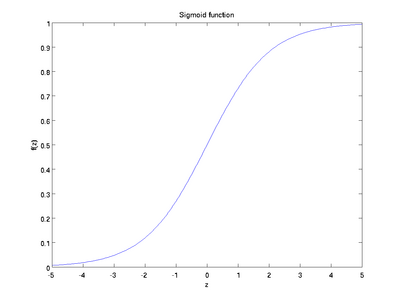
Finally, one identity that'll be useful later: If f(z) = 1 / (1 + exp( − z)) is the sigmoid function, then its derivative is given by f'(z) = f(z)(1 − f(z))
sigmoid 函数 或 tanh 函数都可用来完成非线性映射
Neural Network model
A neural network is put together by hooking together many of our simple "neurons," so that the output of a neuron can be the input of another. For example, here is a small neural network:
In this figure, we have used circles to also denote the inputs to the network. The circles labeled "+1" are called bias units, and correspond to the intercept term. The leftmost layer of the network is called the input layer, and the rightmost layer the output layer (which, in this example, has only one node). The middle layer of nodes is called the hidden layer, because its values are not observed in the training set. We also say that our example neural network has 3 input units (not counting the bias unit), 3 hidden units, and 1 output unit.
Our neural network has parameters (W,b) = (W(1),b(1),W(2),b(2)), where we write
to denote the parameter (or weight) associated with the connection between unit j in layer l, and unit i in layerl + 1. (Note the order of the indices.) Also,
is the bias associated with unit i in layer l + 1.
We will write
to denote the activation (meaning output value) of unit i in layer l. For l = 1, we also use
to denote the i-th input. Given a fixed setting of the parameters W,b, our neural network defines a hypothesis hW,b(x) that outputs a real number. Specifically, the computation that this neural network represents is given by:
每层都是线性组合 + 非线性映射
In the sequel, we also let
denote the total weighted sum of inputs to unit i in layer l, including the bias term (e.g.,
), so that
.
Note that this easily lends itself to a more compact notation. Specifically, if we extend the activation function
to apply to vectors in an element-wise fashion (i.e., f([z1,z2,z3]) = [f(z1),f(z2),f(z3)]), then we can write the equations above more compactly as:
We call this step forward propagation.
Backpropagation Algorithm
for a single training example (x,y), we define the cost function with respect to that single example to be:
This is a (one-half) squared-error cost function. Given a training set of m examples, we then define the overall cost function to be:
J(W,b;x,y) is the squared error cost with respect to a single example; J(W,b) is the overall cost function, which includes the weight decay term.
Our goal is to minimize J(W,b) as a function of W and b. To train our neural network, we will initialize each parameter
and each
to a small random value near zero (say according to a Normal(0,ε2) distribution for some small ε, say 0.01), and then apply an optimization algorithm such as batch gradient descent.Finally, note that it is important to initialize the parameters randomly, rather than to all 0's. If all the parameters start off at identical values, then all the hidden layer units will end up learning the same function of the input (more formally,
will be the same for all values of i, so that
for any input x). The random initialization serves the purpose of symmetry breaking.
One iteration of gradient descent updates the parameters W,b as follows:
The two lines above differ slightly because weight decay is applied to W but not b.
The intuition behind the backpropagation algorithm is as follows. Given a training example (x,y), we will first run a "forward pass" to compute all the activations throughout the network, including the output value of the hypothesis hW,b(x). Then, for each node i in layer l, we would like to compute an "error term"
that measures how much that node was "responsible" for any errors in our output.
For an output node, we can directly measure the difference between the network's activation and the true target value, and use that to define
(where layer nl is the output layer). For hidden units, we will compute
based on a weighted average of the error terms of the nodes that uses
as an input. In detail, here is the backpropagation algorithm:
- 1,Perform a feedforward pass, computing the activations for layers L2, L3, and so on up to the output layer
.
2,For each output unit i in layer nl (the output layer), set
For
For each node i in layer l, set
4,Compute the desired partial derivatives, which are given as:
We will use "
" to denote the element-wise product operator (denoted ".*" in Matlab or Octave, and also called the Hadamard product), so that if
, then
. Similar to how we extended the definition of
to apply element-wise to vectors, we also do the same for
(so that
).
The algorithm can then be written:
- 1,Perform a feedforward pass, computing the activations for layers
,
, up to the output layer
, using the equations defining the forward propagation steps
2,For the output layer (layer
), set
3,For
- Set
4,Compute the desired partial derivatives:
Implementation note: In steps 2 and 3 above, we need to compute
for each value of
. Assuming
is the sigmoid activation function, we would already have
stored away from the forward pass through the network. Thus, using the expression that we worked out earlier for
, we can compute this as
.
Finally, we are ready to describe the full gradient descent algorithm. In the pseudo-code below,
is a matrix (of the same dimension as
), and
is a vector (of the same dimension as
). Note that in this notation, "
" is a matrix, and in particular it isn't "
times
." We implement one iteration of batch gradient descent as follows:
- 1,Set
,
(matrix/vector of zeros) for all
.
- 2,For
to
,
- Use backpropagation to compute
and
.
- Set
.
- Set
.
- 3,Update the parameters:
Sparse Autoencoder(一)的更多相关文章
- Deep Learning 1_深度学习UFLDL教程:Sparse Autoencoder练习(斯坦福大学深度学习教程)
1前言 本人写技术博客的目的,其实是感觉好多东西,很长一段时间不动就会忘记了,为了加深学习记忆以及方便以后可能忘记后能很快回忆起自己曾经学过的东西. 首先,在网上找了一些资料,看见介绍说UFLDL很不 ...
- (六)6.5 Neurons Networks Implements of Sparse Autoencoder
一大波matlab代码正在靠近.- -! sparse autoencoder的一个实例练习,这个例子所要实现的内容大概如下:从给定的很多张自然图片中截取出大小为8*8的小patches图片共1000 ...
- UFLDL实验报告2:Sparse Autoencoder
Sparse Autoencoder稀疏自编码器实验报告 1.Sparse Autoencoder稀疏自编码器实验描述 自编码神经网络是一种无监督学习算法,它使用了反向传播算法,并让目标值等于输入值, ...
- 七、Sparse Autoencoder介绍
目前为止,我们已经讨论了神经网络在有监督学习中的应用.在有监督学习中,训练样本是有类别标签的.现在假设我们只有一个没有带类别标签的训练样本集合 ,其中 .自编码神经网络是一种无监督学习算法,它使用 ...
- CS229 6.5 Neurons Networks Implements of Sparse Autoencoder
sparse autoencoder的一个实例练习,这个例子所要实现的内容大概如下:从给定的很多张自然图片中截取出大小为8*8的小patches图片共10000张,现在需要用sparse autoen ...
- 【DeepLearning】Exercise:Sparse Autoencoder
Exercise:Sparse Autoencoder 习题的链接:Exercise:Sparse Autoencoder 注意点: 1.训练样本像素值需要归一化. 因为输出层的激活函数是logist ...
- Sparse AutoEncoder简介
1. AutoEncoder AutoEncoder是一种特殊的三层神经网络, 其输出等于输入:\(y^{(i)}=x^{(i)}\), 如下图所示: 亦即AutoEncoder想学到的函数为\(f_ ...
- Exercise:Sparse Autoencoder
斯坦福deep learning教程中的自稀疏编码器的练习,主要是参考了 http://www.cnblogs.com/tornadomeet/archive/2013/03/20/2970724 ...
- DL二(稀疏自编码器 Sparse Autoencoder)
稀疏自编码器 Sparse Autoencoder 一神经网络(Neural Networks) 1.1 基本术语 神经网络(neural networks) 激活函数(activation func ...
- sparse autoencoder
1.autoencoder autoencoder的目标是通过学习函数,获得其隐藏层作为学习到的新特征. 从L1到L2的过程成为解构,从L2到L3的过程称为重构. 每一层的输出使用sigmoid方法, ...
随机推荐
- XML字符串解析实体类方法
/// <summary> /// XML字符串解析实体类方法 /// </summary> public class StringXML { public StringXML ...
- codeforces 540 B School Marks【贪心】
题意:一共n个数,给出其中k个数,要求这n个数的中位数为y,这n个数的和不超过x,补全剩下的n-k个数 先统计给出的k个数里面比中位数小的数, 如果cnt<=n/2,说明中位数还没有出现,把这n ...
- Mac系统下安装pip
Mac下 pip的安装 编译 Python3.7 终端输入: curl https://bootstrap.pypa.io/get-pip.py | python3 1 安装完成,检查版本信息 pip ...
- struts2.x + Tiles2.x读取多个xml 配置文件
在web.xml中配置如下即可: <context-param> <param-name>org.apache.tiles.impl.BasicTilesContainer.D ...
- Linux LVM(逻辑卷管理)
Lvm基本应用 什么是LVM? LVM 的全称是 Logical Volume Manager.中文为逻辑卷管理.它是Linux对磁盘分区的一种管理机制.它在传统的硬盘(或硬盘分区)和文件系统之间建立 ...
- Android Private Libraries 和 Dependencies的区别
Android项目开发中,是不是常看到android-support-v4.jar.appcompat_v7.jar等的jar包? 至于为什么要添加这些包?添加有什么用?添加到哪里?相信很多人没过多关 ...
- thinkphp中cookie和session中操作数组的方法
thinkphp中cookie和session中操作数组的方法 一.ThinkPHP模板中如何操作session,以及如果session中保存的是数组的情况 在ThinkPHP的模板中操作sessio ...
- orm 通用方法——DeleteModel 主键删除
定义代码: /** * 描述:删除对象 * 作者:Tianqi * 日期:2014-09-17 * param:model 对象实例,包含主键 * return:int 受影响行数 * return: ...
- dubbo问题求解
各位大牛好,小弟公司开发中遇到一个很奇怪的问题望有大神指教一下,实在是已经搞了3天了一点头绪没有,公司使用的是eclipse+maven+zookeper+dubbo主要是dubbo的问题,刚开始使用 ...
- Announcing Zuul: Edge Service in the Cloud--转
原文地址:http://techblog.netflix.com/2013/06/announcing-zuul-edge-service-in-cloud.html The Netflix st ...

